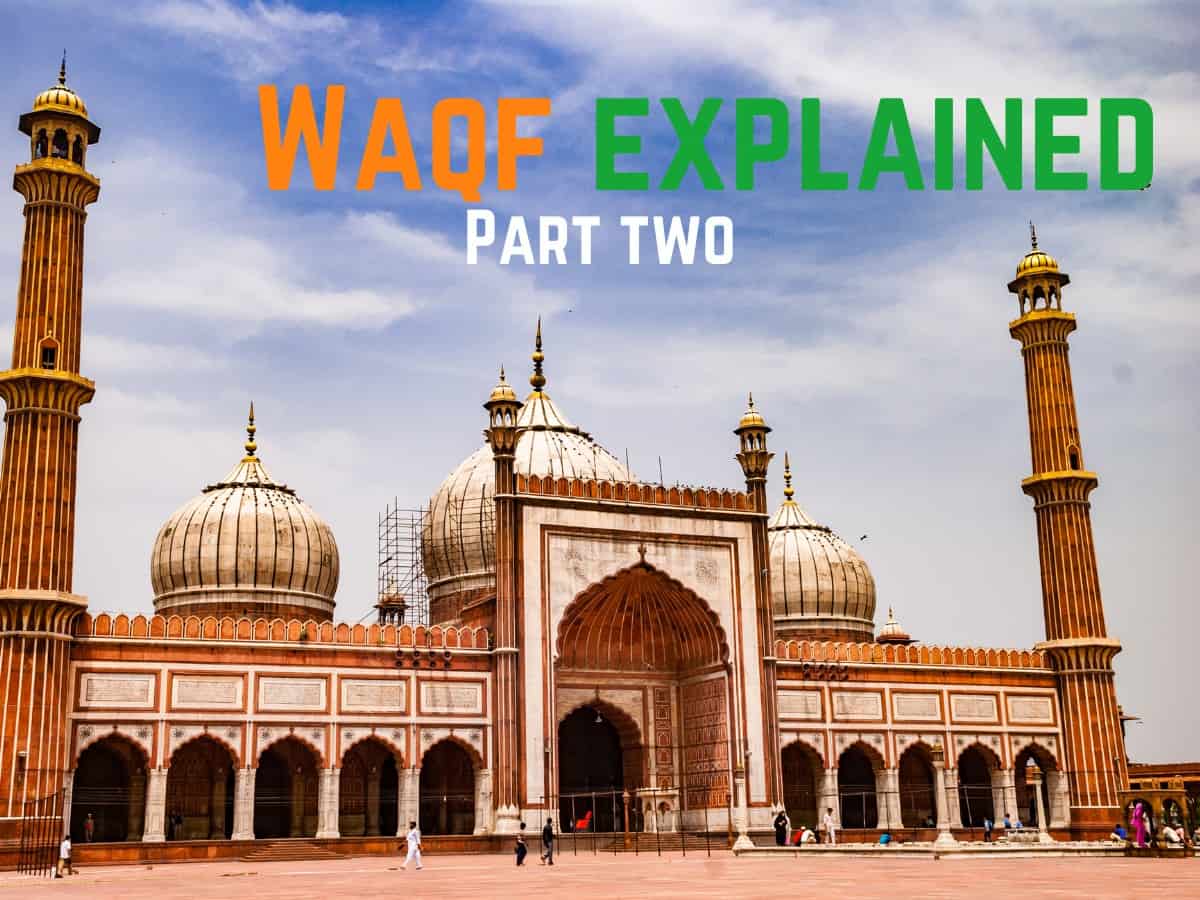
The report claims to highlight the need to prevent the misuse of Waqf properties for personal gain or unauthorized purposes, but that it does not. That need, need not have been highlighted. For the past few decades we have seen encroachment of Waqf properties, Waqf institutions losing cases after cases in relation to Waqf properties, judicial decisions which have disillusioned and at times demoralised persons interested in protection of Waqf institutions and their assets and what stares us in the face did not require any highlighting at all.
Waqf properties—the future
Far from ensuring that Waqf properties are used for their intended religious or charitable purposes, the present dispensation actually eyes Waqf properties with the intention of claiming those as its own and that does not appear to cause any great consternation in the only establishment where disputes are resolved or ought to be.
There is an old, old saying that dates back to the time of the African struggle against slavery and it goes “The Master’s tools will never dismantle the Master’s house.” To expect those very people who have been clamouring against Waqf institutions and the institution of Waqfs itself, and have been making allegations that the Waqf Board encroaches and claims government land as its own, to create a mechanism that actually protects Waqf properties from encroachment and even ensures that Waqf properties are used for their intended religious or charitable purposes, does not evoke credibility.
This is even more glaringly clear when we see that modern legislation seems to be crafted to ensure that people’s right to convert to the religion of their choice is curtailed ostensibly only to regulate conversions which desire is born out of the fear psychosis created considering that all over the world Islam seems to be the religion towards which more and more people are gravitating notwithstanding the canards the slurs and the misinformation that is deliberately spread about the religion.
The amendment allegedly proposes the establishment of faster and more efficient dispute resolution mechanisms for Waqf-related cases. It is claimed this could reduce the backlog of cases in courts and provide quicker resolution to disputes, thereby safeguarding Waqf properties from prolonged legal battles. I consider the claim far-fetched and fanciful because for quite some time now we have had alleged Fast Track Courts, and it is common knowledge that justice cannot be fast tracked. Justice requires careful deliberated examination of records and a careful, objective, unbiased, nonpartisan hearing of both sides of every narrative, sometimes multiple sides of each narrative and then adjudicating a dispute with a great deal of conscientiousness, application and concern to ensure that justice is served.
What presently obtains is that people who are able to pay large amounts of money and can hire better lawyers usually succeed as compared to those people who cannot afford the same. Besides this as far as Hyderabad itself is concerned I recall seeing a different high court flag on the vehicles of judges of the high court as compared to the state flag which would fly on state vehicles clearly highlighting the distinction between the state and the judiciary but today the same flag flies everywhere suggesting a kinship which derogates from the separation of powers concept that the constitution guaranteed. Pictures of a religious type on display in government buildings tell us of the erosion of the secular character of certain institutions.
Community participation
The report allegedly emphasizes the importance of involving the Muslim community in the management and protection of Waqf properties claiming that greater community participation could lead to more effective oversight and ensure that the interests of the community are adequately represented, That, sadly, would be only if the persons who were placed in positions to monitor the management and protection of Waqf properties were persons of known integrity and whose concern it is to uphold and promote the rights of the Waqf Institutions and protect them from mismanagement encroachment etc and not hand-picked lackeys of the government who would merely repeat glibly what the government wants them to, resulting in a farcical exercise achieving the reverse of what ostensibly is sought to be achieved.
The amendment allegedly seeks to improve the financial sustainability of Waqf Boards by enabling them to generate revenue from Waqf properties. It is claimed that this could provide Waqf Boards with the necessary funds to maintain and develop Waqf properties, benefiting the community at large. Here again I have very serious reservations. In umpteen cases in the past we have seen that when Waqf institutions went to the government seeking permission to lease out Waqf properties for long periods, officialdom has merely sat on them and not given the Waqf Institutions the clearances required.
For 20 years now I have been writing about how large extents of waqf land can be used to tie up with top level universities around the world particularly naming Harvard, Stanford, Yale, UCL, Georgia, LSE, Cambridge, Oxford, etc., and now Singularity, where the waqf provides the land, the university creates the infrastructure and by virtual links, a state-of-the-art education of the highest level available in the world can be brought at the doorstep of Indian students enabling them to access the highest level of intellectual exposure at a fraction of the cost that it would take them to go abroad to these institutions and study while living there at those expense levels. Muthawallis’ consent is almost guaranteed when it is noted that a fraction of the revenue generated would go to them, enabling them to earn legitimately what is received by them from the back door, as is often alleged.
Vishwa-guru concept
Not only would this create an amazing nucleus of intellectual activity locally dovetailing with the Vishwa-guru concept, It would ensure that large numbers of students from Third World countries flocking to those Western institutions would instead come to India for the same education by the same faculty, with the resulting high level exchange of intellectual ideas within our country creating an amazing situation of intellectual dynamism.
As an ancillary fallout there would be the inflow of foreign exchange, the protection of the Waqf properties and the spurring of supporting feeder services growing all around the properties driving economic activity as well as enhancing the intrinsic value of the Waqf property, adding taxes to the State exchequer. Not once has any voice in the government ever responded to these ideas, and to think suddenly that the government would proactively go out and do what it has resisted all along requires one to stretch one’s credibility breaching constraints of logic experience and expectation.
It is said that the success of the amendment depends on effective implementation, which may face challenges due to bureaucratic inefficiencies or lack of resources. Resources will very likely not be allocated in order to starve institutions of which a quick death is desired by the powers that be. Political sensitivity is palpable as is political hostility and what is touted as the amendment facingopposition or criticism from certain quarters is actually an apprehension that the flaws will eventually become public because of the expected partisan nature of implementation when it becomes visible, which most believe is inevitable. Then, it can be said that the amendment is facing opposition or criticism from “detractors” even labelling them anti-national.
Bad track record of executive
The executive in India does not act properly or in time to protect Waqf institutions reflecting a Muslim heritage, influenced by a combination of historical, political, and social factors. Government decisions often reflect political priorities, and protecting Muslim heritage sites which many politicians actually see as eyesores, does not go well with the ruling party’s ideological stance or electoral strategy in certain cases, guaranteeing neglect or lack of serious effort.
Also, in a democracy where numbers win elections, governments prioritize policies and actions that cater to majority sentiments to ensure their return to power. In India, where Hindus form the majority, heritage linked to Muslim culture would obviously not receive emphasis, especially now that it is a politically sensitive electoral issue as well.
Preservation of Waqf and heritage sites, in general, often suffers from a lack of resources, lack of funding, official disinterest and deliberate neglect, despite their religious and cultural heritage significance, added with bureaucratic inefficiencies and limited budgets being sanctioned and even sanctioned budget releases being sometimes delayed.
Historical narratives in India are increasingly polarized, with certain groups viewing Muslim heritage as a reminder of invasions or perceived oppression during the medieval period, making falsified claims which buy into lack of political will to protect such sites, and even indications of a will to destroy these. The acquittal of people responsible for destruction of buildings in plain video coverage by ajudicial establishment that disappointed, stare at us disillusioning us, and emboldening aggressors.
Massive destruction
The reluctance of the executive to prevent the massive destruction of a cultural and religious heritage of Babri Masjid by acting to nip the matter in the bud despite reading the writing on the wall were all signs of the direction later events would take and it is fallacious to assume that there will be a sudden awakening of political, executive, administrative, judicial and bureaucratic consciences in one startling paradigm shift heralding a bold new dawn. That happens in fairy tales.
The Muslim community lacks the organization, resources, or influence to effectively advocate for preservation of waqfs. Its voices are not even given in media the coverage or space they merit. Without strong public pressure, the executive will not act. Public pressure is ignored unless there are disruptive protests, and while some disruptive majoritarian protests of which videos have gone viral have still not merited political or executive response, or suo motujudicial response, similarly disruptive actions by minority groups are likely to invite immediate, harsh, repressive measures rendering them an unsafe thought.
Responsibility for heritage protection is often shared between multiple agencies like Archaeological Survey of India, state governments, departments like that of Museums, Urban Development Authorities, etc., leading to inefficiency, inaction,lack of coordination, and worse. When one type of heritage is seen as a reminder of ostensible, alleged past enslavement, to expect it will still find protective steps being taken, again requires the stretching of an imagination beyond reasonable requirements as well as an ignoring of a past history of hostility and neglect.
This is despite some Muslim heritage sites in India being projected as part of the country’s “rich cultural history”, Taj Mahal, Qutb Minar, and Humayun’s Tomb being examples. However, the phrase that comes to mind is lip service. This is a transitory ostensible stand, just as the report of Justice Krishna Iyer re Mumbai carnage is touted as exemplifying the independence and objectivity of India’s judicial officers, while at the same time its recommendations have not yet found implementation after passage of decades. Reports, and their implementation, stand poles apart.
Political posturing today passes for positive proactive action, which it is not. It is more likely camouflaged action with likely sinister portents. Time will tell us which.
Jai Hind.




